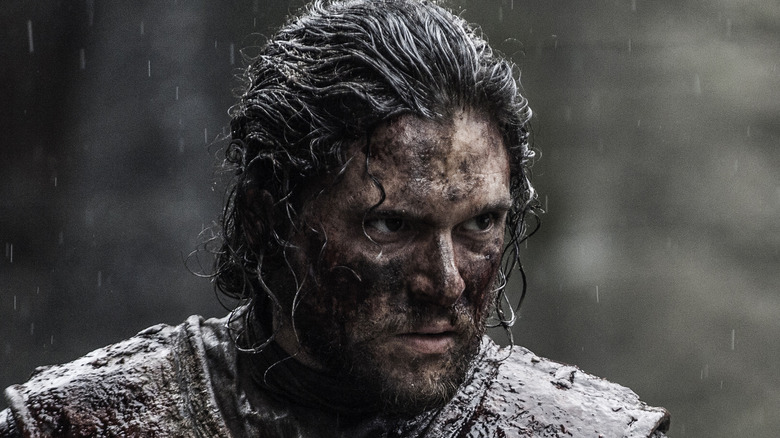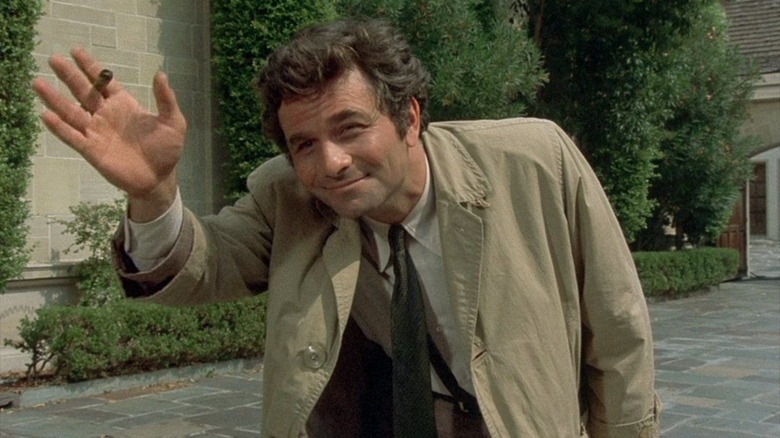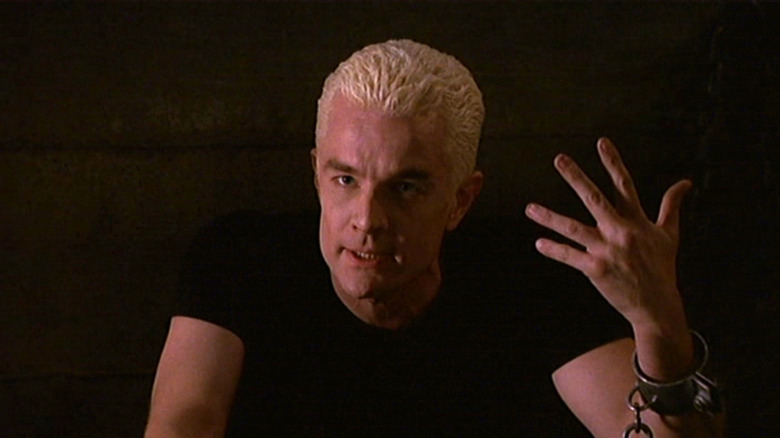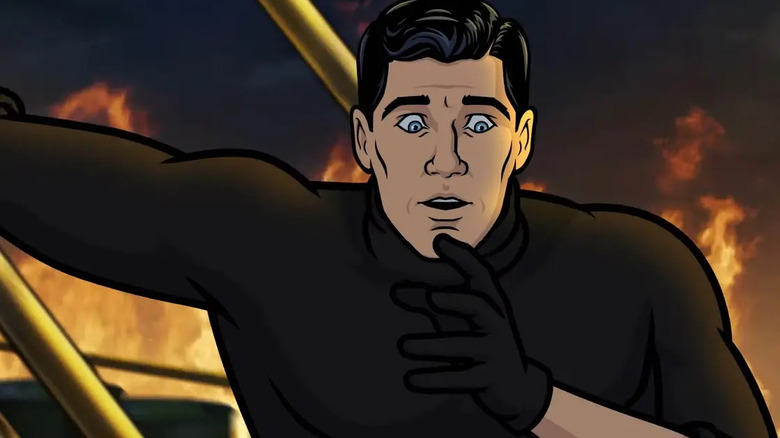TV Characters With The Most Plot Armor
In a good story, much is at stake, tensions are high, and the hero is vulnerable. If they screw up, they're toast — and so is everyone counting on them — so they have to be careful as well as brave.
But ugh, who has time for all that? Why take the time to write a surprising but reasonable way for the hero to apply all the hard lessons they've learned thus far to barely get past this group of goons or the next boss fight, when you can just, you know, have a piano fall on the bad guy's head instead? Or have the Big Bad inexplicably monologue long enough for the hero to find a gun with one bullet left in it? Or have the protagonist fall from the top of a skyscraper, only to reveal at the beginning of the next episode that they somehow limped away with minor scrapes and bruises? Doesn't make sense? Listen, they need the script for next week's episode by the end of the day, so get off our back, will ya?
Thing is, characters don't make it through all the plot developments they have to endure without a little help from the screenwriters. But some instances of improbable luck, death fake-outs, impossible physical endurance, and deus ex machinas can be more absurd than others. From Columbo to Jon Snow, these are the TV characters with the thickest plot armor.
Columbo from Columbo
Long-running detective shows are something of a high wire act, since they have to keep your attention for years, often by shoving non-superpowered protagonists into increasingly dangerous circumstances. Usually we're talking about the Maverick Who Gets Results, whose reckless but brilliant personality only increases the danger (but not really, because the network just renewed the show for 12 more seasons). Columbo, from "Columbo," is a bit different, personality-wise — but the frumpy, disarmingly friendly sleuth still had a knack for getting himself into dangerous situations and always coming out on top.
Most episodes of the show began with the crime of the week, and while you the viewer know the killer's identity, Columbo doesn't. But he's not far behind. He pops in, asks his questions, and quickly figures things out without overplaying his hand. Now he needs proof, but his methods are rather unorthodox. In many if not most episodes, his approach involves manipulating the killer into trying to take him out, often using the same method they employed in the original crime. Boom: now he knows exactly what went down and can finally haul them in.
You can see where we're going with this. Columbo constantly puts himself in extreme danger (like when he almost gets decapitated via guillotine) to bring in the perp. Not even the luckiest, wittiest detective could stick their head in a noose that many times and never fail to get away with it.
Hannibal from Hannibal
"Hannibal," which follows cannibalistic criminal mastermind Hannibal Lecter of "Silence of the Lambs" infamy (though played here by Mads Mikkelsen rather than Anthony Hopkins), features in its 39 episodes more instances of plot armor and other ludicrously improbable conveniences for the main character than many shows that lasted far longer.
Cleverly, not all of this plot armor actually seems like plot armor, at least at first glance. But you don't necessarily have to survive a 50-foot drop or repeatedly come back from the dead with no good explanation to qualify for this list. Many storylines break Hannibal's way supposedly because of his peerless intellect, not to mention his skills as a martial arts master, a world-class chef, musician, and artist (as well as a razor-sharp dresser with infinite charm). So you could explain much of Hannibal's incredible luck by pointing to his advantageous character traits. But when a character is this unrealistically smart, to the point that they're capable of predicting how almost everyone else thinks despite having no information to base those intuitions on and still never being wrong about it, that counts as plot armor. In many circumstances, the obliviousness of his foes contributes to his evading detection in increasingly silly ways too. That can also be plot armor when it happens all the time, and a reasonable person in their position would've realized something was wrong.
Other than Batman, this version of Hannibal might be the most overpowered non-superpowered fictional character of all time.
Spike from Buffy the Vampire Slayer
Aversion to sunlight is a nearly universal vampire trope. In some properties, vampires get sick when it's sunny out. In others, they get painful burns. In still others, they burst into flames or disintegrate into ancient ash the second any part of their body touches a sunbeam. It all depends on which rules the storyteller feels like sticking to and how they decide to apply them.
In "Buffy the Vampire Slayer," whether a vampire is instantly dusted by sunlight or merely winces in pain and has a reasonable amount of time to find some shadows to hide in apparently depends on whether or not their name is Spike.
Whereas no-name vampire characters on the show burn to death instantaneously, Spike is able to survive a bright blue sky on numerous occasions either because he puts a rug over his head or, like when Buffy removes the Gem of Amarra from his finger during an outdoor daytime fight, he inexplicably has enough time to make it to the safety of a nearby shadow.
But his unfair plot armor isn't restricted to sunlight. In one Season 4 episode, Spike is shot in the chest with multiple arrows. Sure, they miss his heart, but we've seen lesser vampires crumble to ash from hits that look less deadly. The character's then-newfound status as a recurring character is the only explanation for his beefed-up health stats.
June from The Handmaid's Tale
Based on Margaret Atwood's novel of the same name, "The Handmaid's Tale" takes place in Gilead, a totalitarian theocracy that brutally oppresses women and relegates them to second class citizens by freezing their bank accounts, seizing their property, and forbidding them from having jobs. In this world, any perceived defiance by women is met with terrifying consequences including but not limited to mutilation, hanging, beating, solitary confinement, or worse. And by any perceived defiance, we really mean any perceived defiance. You don't have to try to assassinate political leaders, lead insurgencies, or rob banks to be sentenced to some form of horrific punishment. In one episode, for example, Janine has an eye gouged out for speaking back to an authority figure. In another, Emily is forced to endure genital mutilation for having a homosexual affair. Still other characters throughout the series have fingers chopped off and tongues cut out for "offenses" like speaking out against a stoning and reading books.
And yet although she's one of the most defiant Handmaids, protagonist June Osborne, known formerly as Offred #2, always manages to evade such punishment. That's not to say she's not "dealt with," so to speak. She's forced to endure all sorts of harrowing trials and tribulations courtesy of her patriarchal overlords, but most of these are psychological in nature. At no point does she have body parts hacked off despite doing everything in her power to "deserve" it, at least by Gilead's brutal, backwards standards.
Jack Bauer from 24
Compared to many other shows in its genre, "24" went to more respectable lengths in order to avoid goofy tropes like excessive plot armor — but there's only so much you can do to keep a character like Jack Bauer grounded when he's the one man alive seemingly capable of thwarting assassinations, gunfights, nuclear threats, bioweapons, kidnappings of his family, and terrorist attacks. As Michigan Daily points out, the show somewhat circumvented this by having Jack's friends and family be fair game for whoever served as any given season's Big Bad. So while bullets make 90-degree angles when heading for Jack himself, they'll probably wind up hitting one of his loved ones; for example, his pregnant wife's death at the end of Season 1.
Still, the most improbable example of plot armor on the show does involve Jack himself. In Season 7, he gets injected with a deadly prion pathogen and seemingly resigns himself to his fate by rejecting a potentially life-saving stem cell operation simply because it would require a compatible family member (in this case, his daughter Kim) to donate tissue. But wouldn't you know it — "24" got renewed for Season 8, so the convenient miracle cure went ahead anyway while Jack was in a medically induced coma. Thank the network gods!
Multiple characters on Supernatural
This might be cheating, but "Supernatural's" ludicrous plot armor is enjoyed by multiple protagonists and is fairly evenly spread out. Bobby and Castiel, for example, die in Season 7. Conveniently, viewers might pick up on the fact that Castiel's dead body is never seen; despite the fact that an entire episode was dedicated to his demise, he returns in good health before too long. Bobby is only "dead" in a physical sense, but returns as a ghost. But we suppose we won't count that as traditional plot armor.
As for protagonist brothers Dean and Sam Winchester, their, well, supernatural good luck becomes so outrageous in later seasons that even a show this famously, delightfully over the top eventually felt compelled to address it directly. In Season 15, God himself reveals, right before Sam is about to trap him with magic, that he was the one dishing out heaping helpings of plot armor on the Winchesters. If he's out of the picture, they can't count on their famous immunities and good luck. Sure enough, the second they deal with him, the two start getting sick while their trusty appliances suffer routine breakdowns and malfunctions. Still, they're not getting strangled by demons, so we're not sure a common cold or a short circuiting microwave counts as a chink in their plot armor. Besides, it's all temporary: Sam and Dean eventually challenge a goddess to a game of chance and win back their good fortune.
Sterling Archer from Archer
"Things just sort of always work out for me," Sterling Archer likes to say. Yeah, that's an understatement. The secret agent protagonist of the adult animated sitcom "Archer" has been in so many near-fatal situations that it's amazing he's still walking around years later. Sometimes he gets away scot free because of random coincidences, or because the episode's villain starts unwisely monologuing. But even when he can't dodge danger like this, he comes out on top. In different episodes he has survived cancer, snake bites, and being shot repeatedly in the chest with a .44 Magnum. Minutes later, as he's slumped up against the wall bleeding profusely, he's making wisecracks.
Which brings us to the one asterisk here: this is all part of the fun of "Archer." This isn't the type of show where solid early plots give way to increasingly lazy and contrived storylines as the writers run out of ideas. Archer, essentially a comically exaggerated James Bond, has always been blessed with improbable levels of death-defying luck. It's part of the charm, so the show is in on the joke, and Archer himself seems to be loosely aware that the odds are stacked in his favor. His distinctive cockiness is as much a result of his jaw-dropping luck as it is a cover for the emotional wounds inflicted by his rough, loveless upbringing. And much of the show's dialogue, from the title character on down to everyone else, pokes fun at — and takes for granted — his nigh-invulnerability.
Doctor Who from Doctor Who
In a good episode of "Doctor Who," the Doctor employs quick thinking to escape run-ins with deadly aliens, killer cyborgs, and all other manner of inter-dimensional or extraterrestrial baddies. But there have been more than a few instances where improbable luck saved the day instead — the villain inexplicably captures but doesn't kill our hero, for example, or his weird alien biology kicks in when a regular person would've been toast. His regenerative abilities have come in handy more than once after he's sustained what should have been fatal wounds.
Sometimes it's just good ol' fashioned plot armor without even a lazy explanation from the lore. For example, in the episode "The End of Time," the Doctor leaps from a crashing spaceship, reaches terminal velocity on a massive fall, then smashes through a skylight and slams into a marble floor. Even an Olympian would be a soup of blood and innards after an accident like that, but the Doctor is able to limp away with scrapes and bruises. Huh?
But at the show's most ludicrous, it seems as if the Doctor is able to twist the laws of physics themselves to eke out improbable 11th-hour wins when all looks lost. Just ask the Master, who earned his victory in "The Last of the Time Lords" only to be beaten when the defeated Doctor was resurrected. How? Because everyone on Earth merely thought the word "Doctor" and somehow channeled enough psychic power into his corpse to bring him back.
Jon Snow from Game of Thrones
In early seasons of "Game of Thrones," noble characters made mistakes and lost their lives, while wiser villains survived. This "no character is safe" principle made for some pretty compelling TV, but by the second half of the show, it had been enthusiastically discarded for numerous characters. Arya, for example, is repeatedly stabbed in Braavos, only to take a nap and wake up with no side effects. Go figure.
But Jon Snow didn't just have plot armor: he had a plot force field. There were a few questionable incidents in the early seasons, but the show did a decent job explaining them (like when scorned Wildling girlfriend Ygritte shot him three times but loved him too much to aim for the heart). But it only got more ridiculous. Jon is resurrected by Melisandre's dark magic after being murdered by his own Night's Watch brethren for helping enemy Wildling south of the wall. Then, at the Battle of the Bastards, Jon endangers his entire army with a reckless one-man charge, survives repeated arrow volleys which slaughter everyone around him, then gets his army trapped and nearly suffocates in the human crush before last-minute reinforcements save the day. In Season 7, Jon is trapped by zombie hordes north of the wall but somehow manages to climb out from beneath the ice just in time for long-lost Uncle Benji to ride up, offer his horse, and die immediately while Jon escapes. Thanks for the ride!
Ichigo on Bleach
No genre uses and abuses plot armor more than anime, and no anime gorges on it quite like "Bleach." Based on the manga of the same name, the story of the show follows Ichigo Kurosaki, who uses his Soul Reaper powers to defend humans from demonic beings and escort dead souls safely to the afterlife. Naturally, he finds himself in all sorts of dangerous circumstances throughout the series' 366 episodes, and the show shamelessly uses every conceivable manifestation of this trope to get him across the finish line: deus ex machina, resurrections, death fake-outs, last-minute developments that turn the tide at the last second, inconsistently deadly weapons and enemies who can't help but monologue just long enough for the hero to throw together some kind of insane Hail Mary. You name it.
In one episode, for example, Ichigo just so happens to receive a special arrowhead that nullifies the otherwise invincible King Yhwach's Almighty power, just long enough to land a killing stroke. In another, he receives a bankai (the second, powerful release from his magical katana) in three days, simply because the plot doesn't want to spend time showing him training for decades to achieve this like the lore clearly insists is necessary. In yet another story, Ichigo loses a battle against Tesla Lindocruz fair and square, but Tesla inexplicably takes his time beating up Ichigo rather than killing him quickly, giving another character a chance to show up and save the hero.
Homer Simpson from The Simpsons
Normally, "plot armor" is reserved for characters who frequently get into gunfights or have to defuse bombs. Homer Simpson is no action hero, but his sheer buffoonery more than makes up for this.
In the last 30-plus years, Homer has survived flying off cliffs, Bart smashing him in the head with a chair, impaling himself in the eye with a straw, sticking his head out a car window and smashing face-first into a series of mailboxes, getting run over and crushed by cars, having his garage door repeatedly smash into his head, being smashed into by a wrecking ball that slammed him into buildings, having his head caught between two halves of a closing bridge, getting beaten up, shot with nail guns, hit with mallets, strangled, repeatedly electrocuted, getting his face stuck in a vacuum cleaner, struck by lightning in the mouth after daring God to "turn the rainwater into wine," spraying himself in the eye with spider poison after having his face covered in arachnids, nearly getting killed in an avalanche, having a bathtub fall on his head, tumbling off roofs, and so many other would-be-fatal accidents we couldn't possibly catalog them all.
You could say the same thing about multiple animated characters, of course: especially those who are part of shows that have been on the air for hundreds of episodes spread over decades. But Homer was and always will be adult animation's quintessential doofus, whose invulnerability is matched only by his sheer idiocy.











